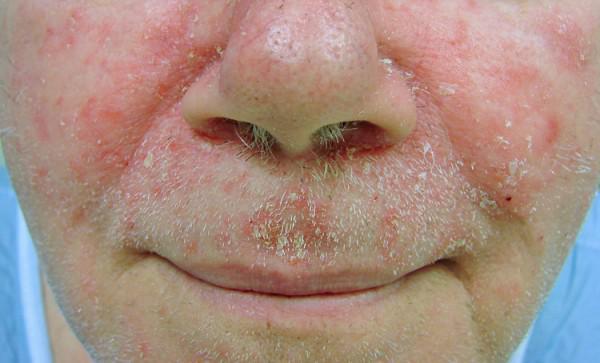SEBORRHEIC DERMATITIS

Definition: Seborrheic Dermatitis is a common, chronic inflammatory skin disorder that causes flaky, white to yellowish scales to form on oily areas. It can occur with or without reddened skin.
Other names: Seborrheic eczema, dandruff. Cradle cap is the term used when seborrheic dermatitis affects the scalp of infants.[1]
Causes
Seborrheic dermatitis is thought to be due to a combination of an over production of skin oil and irritation from a yeast called malessizia. It also appears to run in families. Stress, fatigue, weather extremes, oily skin, infrequent shampoos or skin cleaning, use of lotions that contain alcohol, skin disorders (such as acne), or obesity may increase the risk. Neurologic conditions, including Parkinson’s disease and stroke may be associated with seborrheic dermatitis. Human immunodeficiency virus (HIV) has also been linked to increased cases of seborrheic dermatitis. [2]
Symptoms
Seborrheic dermatitis typically forms where the skin is oily or greasy. Commonly affected areas include the scalp, eyebrows, eyelids, creases of the nose, lips, behind the ears, in the external ear, and along skin folds on the middle of the body. Its symptoms can increase or disappear over time.
Symptoms of seborrheic dermatitis include:
- Skin lesions
- Patches of abnormal appearing skin over large area
- Greasy, oily areas of skin
- Skin scales — white and flaking, or yellowish, oily, and adherent — “dandruff”
- Itching
- Mild redness
- Hair loss
Seborrheic dermatitis in infants and small children (cradle cap) is a harmless, temporary condition that often appears as thick, crusty, yellow or brown scales over the child’s scalp. Similar scales may also be found on the eyelids, ear, around the nose, and in the groin. Cradle cap is not contagious or dangerous, nor is it caused by poor hygiene. If it itches, excessive scratching of the area may cause additional inflammation, and breaks in skin may cause mild infections or bleeding. [3]
Treatment
The primary form of treatment for flaking and dryness common in seborrheic dermatitis is with over-the-counter dandruff or medicated shampoos. Shampoo frequently (preferably daily) to loosen scales and scrub with fingers for at least 5 minutes, then rinse thoroughly. Active ingredients in these shampoos include salicylic acid, coal tar, zinc, resorcin, ketoconazole, or selenium.
Shampoos or lotions containing selenium, ketoconazole (broad-spectrum antifungal agent), or corticosteroids may be prescribed for severe cases. To apply shampoos, part the hair into small sections, apply to a small area at a time, and massage into the skin. If on face or chest, apply medicated lotion twice per day. Seborrheic dermatitis may improve in the summer, especially after outdoor activities. If one treatment alone is ineffective, different combinations of the usual agents: a dandruff shampoo, an antifungal agent and a topical steroid, may be prescribed by a doctor.
For infants with cradle cap, the treatment is much the same as it is for adults. Massage the baby’s scalp with fingers or soft brush to loosen scales and give the child daily, gentle shampoos with a mild soap while scales are present. After scales have disappeared, you may reduce shampoos to twice weekly. Brushing hair following shampooing will also help loosen scales.
If scales do not easily loosen and wash off, applying some mineral oil to the baby’s scalp and wrapping warm, wet cloths around the head for up to an hour before shampooing will assist with loosening the scales. Then, shampoo as directed above. With any further concerns consult your physician who may prescribe a cream or lotion to apply to your baby’s scalp several times a day.[3], [4]
References:
- James, William; Berger, Timothy; Elston, Dirk (2005). Andrews’ Diseases of the Skin: Clinical Dermatology. (10th ed.). Saunders.
- http://www.nlm.nih.gov/medlineplus/ency/article/000963.htm
- Habif TP. Clinical Dermatology. 4th ed. St. Louis, Mo: Mosby; 2004:242-245.
- Murray, Michael; Pizzorno, Joseph (1997). “Encyclopedia of Natural Medicine” (Revised 2nd Edition) Three Rivers Press.


